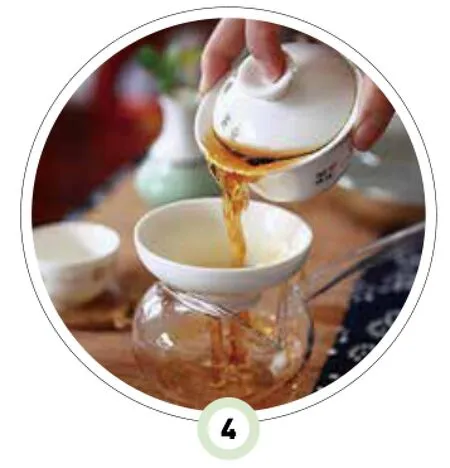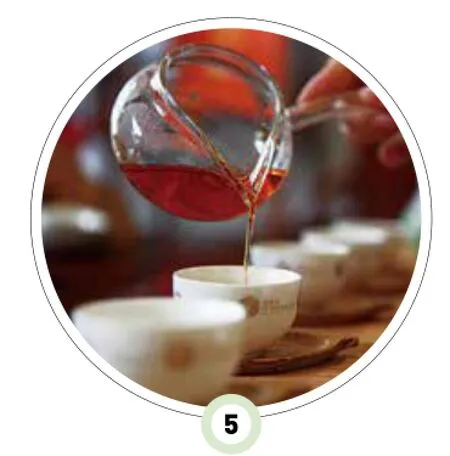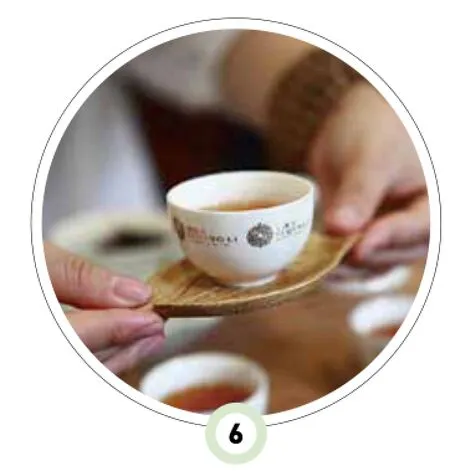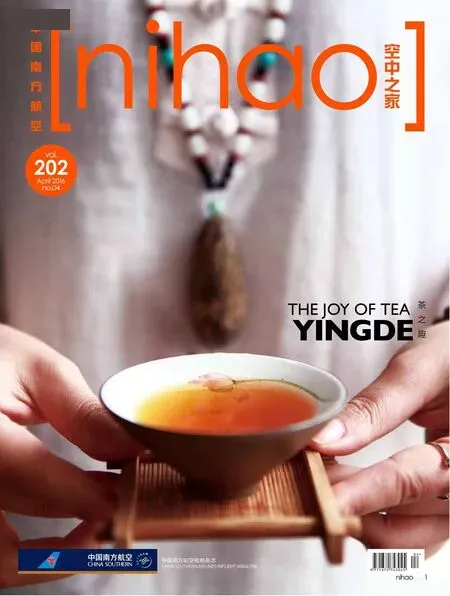茶由心生
茶由心生
琴棋书画,诗酒花茶。茶不仅是中国人生活之必需品,更代表了一种修身养性、天人合一的东方文化理念。小小一杯清茶,在茶艺师手里,被赋予了灵魂。
Chinese high culture can be summed up as: Zither, chess, calligraphy, painting, poetry, wine, flowers, and tea. Tea is considered an essential element of the Chinese lifestyle. The practice of drinking the aromatic beverage represents a cultural philosophy that emphasizes personal perfection and unity between the individual and nature. A tea master and his/her practice can impart cultural essences to a simple cup of tea.
There is a Chinese folk saying that goes: The seven essential elements of any household: Fuel, rice, oil, salt, soy paste, vinegar, and tea. This expression emphasizes the importance of tea throughout China.
It was said that the history of Chinese tea drinking began during the reign of the legendary sage king Shennong. Tea originally served as an appetizer and a beverage for staving off thirst. Later on, the Chinese people integrated the act of drinking tea with ritual, health, and cultural elements. The culture of Chadao (the way of drinking tea) reached its peak of development and popularity in the Tang Dynasty. Chayi (the art of drinking tea), the medium for the practice of Chadao, also emerged during this time.
The Han Chinese practice of tea drinking focuses on Pin (to imbibe). The ritual of preparing and offering tea is an integral part of a host entertaining a friend who has travelled a long way. Traditional procedures describe every single act and gesture with great detail, and its proper practice symbolizes a most warm welcome and respect offered to the guest. Brewing tea is a very simple act: place the tealeaves into a cup and pour some hot water over it. Chayi, however, brings it to another level of sophistication. It must begin with wenbei (warming of the cup) and wenxiang (sampling the aroma). A dozen steps follows suit from pouring hot water to offering the tea to the guest. With a staggering 21 steps, Chaoshan Kungfu Tea is known as the most complicated Chayi procedure.
The simple act of tea drinking is therefore given cultural context and properties through this art.
Ling Jielin is a professional tea master and tea appraiser, and has studied the art for over 10 years. All her gestures, routines, and description of the tea ritual allow guests to appreciate the melodious elegance offered by Eastern cultures.
Ling emphasized that Chayi practitioners must be familiar with the means by which different categories of tea were prepared as well as the practice of Chinese traditional culture in order to attain perfect integration of form and spirit required by Chadao.“When treating guests, the tea master would refer to the season as well as the age of the guests toselect a suitable tea,” she said.
According to Traditional Chinese Medicine, the selection of tea must correspond to the season.
Drinking different teas at different seasons will provide a variety of health effects: spring is perfect for fl oral teas to keep out fevers and generate the Yang spirit. Lucha (green tea) should be drunk in summer to refresh the body and expunge the element of fi re from the body. Qingcha (oolong tea) should be drunk during autumn to prevent dehydration and improve appetite. Hongcha (black tea) should be taken during winter to generate heat and protect the stomach.
A skilled tea master must know the exact amount of water to be poured and how long one has to wait for boiling water to cool down to 80 degrees Celsius to create the perfect tea liquor. They also must exercise precision and know exactly how much tea they have acquired in a single pinch.
The fi rst step of tea brewing is wenbei (cup warming). Boiling water is fi rst poured over the teapot and cups for rinsing. This is then followed by wenxiang (sampling the aroma) where the tealeaves are placed in the warmed teapot to bring out its gentle fragrance. After wenxiang, the tea master shall pour boiling water into the teapot and let it sit for a while. The resulting tea liquor shall then be poured into a bowl used to dispense tea into individual cups, which are fi nally served to the guests.
“Yingde black tea does not require the step of washing and generates a perfect tea liquor within fi ve to eight seconds after pouring. To pin (imbibe) the tea, one must fi rst observe the color of the liquor and appreciate its aroma before drinking.,”described Master Ling.
Every step of Chayi was given enigmatic yet enchanting names such as: the phoenix nods thrice, reversing the heavens and earth, transferring the jade liquor, and water fl owing from the peaks. All these names illustrate how the entire universe and its ecologies can be condensed into a seemingly simple cup of tea.

温杯Cup warming

投茶Placing tea leaves

冲泡Pouring water

出汤Generating tea liquor

分茶Dispensing the tea

奉茶Serving the tea

Ling Jielin, senior tea master and tea appraiser.凌结林,高级茶艺师、国家高级评茶师。
中国有句俗语——开门七件事:柴米油盐酱醋茶——可见茶在这个国度的重要意义。
据说,中国人饮茶的历史始于神农时代,最初只为生津止渴。后来,中国人将礼仪、养生、文化注入饮茶当中。在唐朝,茶道文化开始大行其道。茶艺,作为茶道的载体,也在此时兴起。
汉族人饮茶,讲究一个“品”字,有朋自远方来,主家沏茶、敬茶的礼仪必不可少,沏茶、敬茶从手势到程序都有一定的规矩,以此表现对客人的欢迎与尊重。
泡茶本是颇为简单的行为:放茶叶、倒热水,但茶艺却将其复杂化,从温杯、闻香,到冲泡、奉茶,往往需要十多道程序。最繁琐的潮汕功夫茶甚至前后有21道程序。
饮茶这一行为习惯由此被赋予了文化内涵。
凌结林是高级茶艺师、国家高级评茶师,从小在茶乡长大,学习茶艺有近10年的历史。茶席前,其举手投足、谈吐举止都无不让人领略到东方文化的典雅韵味。
凌结林介绍说,学习茶艺,既要对不同茶类的制作工艺有所了解,又要学习中国传统文化礼仪,这样才能达到形神结合的茶道文化要求。“面对客人时,茶艺师会根据季节以及客人的年龄等选择适合的茶叶冲泡。” 从中医养生角度讲,饮茶分季节。不同季节,喝不同的茶,起不同功效:春饮花茶,驱寒邪,生阳气;夏饮绿茶,清热去火;秋用青茶,清燥生津;冬品红茶,生热养胃。
一位好的茶艺师,不仅要知道注水后多久出茶汤,知道沸水多久后能降到80度,而且手感极准,取一小撮茶叶便知道是几克。
泡茶第一步便是温杯,即用沸水将盖碗、茶杯等冲洗一番,随后便是赏茶闻香,将茶叶放入温热的盖碗,使其香气四溢。闻香后,茶艺师将沸水注入盖碗冲泡茶叶,一定时间后,将盖碗的茶汤倒入茶盅,由茶盅再倒入各个茶杯,分给每位客人。
“品英德红茶,冲泡前无须洗茶,注水后5—8秒就出茶汤,品茶时一看茶汤,二闻茶香,之后便可入口品茶。”凌结林说。
在这一系列的冲泡过程中,几乎每一道程序都有个耐人寻味的名头:凤凰三点头、乾坤倒转、玉液移壶、高山流水……仿佛天地万物此刻都交汇在这一杯一茶中。
TEA FROM THE HEART
Text by Ge Rufeng Photos by Zeng Jian

